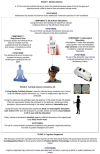From Virtual Reality to Regenerative Virtual Therapy: Some Insights from a Systematic Review Exploring Inner Body Perception in Anorexia and Bulimia Nervosa
- PMID: 36498708
- PMCID: PMC9737310
- DOI: 10.3390/jcm11237134
From Virtual Reality to Regenerative Virtual Therapy: Some Insights from a Systematic Review Exploring Inner Body Perception in Anorexia and Bulimia Nervosa
Abstract
Despite advances in our understanding of the behavioral and molecular factors that underlie the onset and maintenance of Eating Disorders (EDs), it is still necessary to optimize treatment strategies and establish their efficacy. In this context, over the past 25 years, Virtual Reality (VR) has provided creative treatments for a variety of ED symptoms, including body dissatisfaction, craving, and negative emotions. Recently, different researchers suggested that EDs may reflect a broader impairment in multisensory body integration, and a particular VR technique-VR body swapping-has been used to repair it, but with limited clinical results. In this paper, we use the results of a systematic review employing PRISMA guidelines that explore inner body perception in EDs (21 studies included), with the ultimate goal to analyze the features of multisensory impairment associated with this clinical condition and provide possible solutions. Deficits in interoception, proprioception, and vestibular signals were observed across Anorexia and Bulimia Nervosa, suggesting that: (a) alteration of inner body perception might be a crucial feature of EDs, even if further research is needed and; (b) VR, to be effective with these patients, has to simulate/modify both the external and the internal body. Following this outcome, we introduce a new therapeutic approach-Regenerative Virtual Therapy-that integrates VR with different technologies and clinical strategies to regenerate a faulty bodily experience by stimulating the multisensory brain mechanisms and promoting self-regenerative processes within the brain itself.
Keywords: anorexia nervosa; bulimia nervosa; inner body perception; interoception; proprioception; regenerative medicine; vestibular system.
Conflict of interest statement
The authors declare no conflict of interest.
Figures


References
-
- Ferrer-Garcia M., Gutiérrez-Maldonado J., Riva G. Virtual Reality Based Treatments in Eating Disorders and Obesity: A Review. J. Contemp. Psychother. 2013;43:207–221. doi: 10.1007/s10879-013-9240-1. - DOI
-
- Riva G., Bernardelli L., Castelnuovo G., Di Lernia D., Tuena C., Clementi A., Pedroli E., Malighetti C., Sforza F., Wiederhold B., et al. A Virtual Reality-Based Self-Help Intervention for Dealing with the Psychological Distress Associated with the COVID-19 Lockdown: An Effectiveness Study with a Two-Week Follow-Up. Int. J. Environ. Res. Public Health. 2021;18:8188. doi: 10.3390/ijerph18158188. - DOI - PMC - PubMed
Publication types
LinkOut - more resources
Full Text Sources
Miscellaneous

